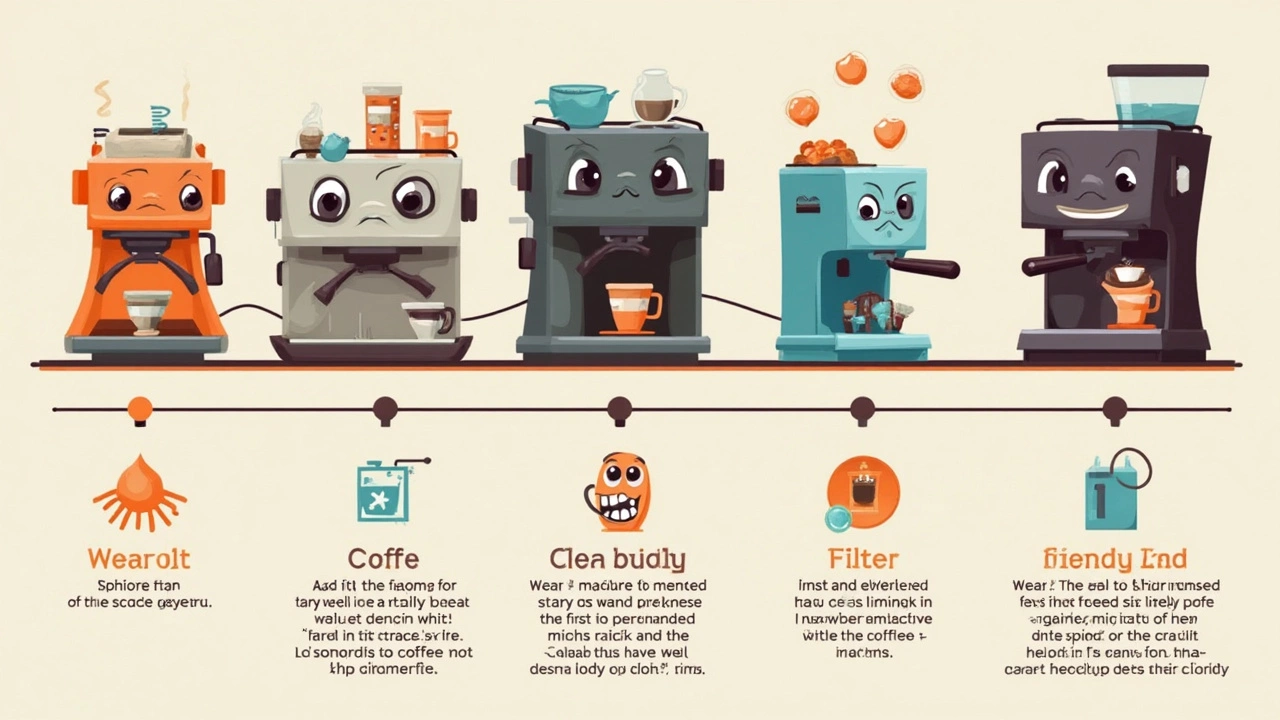
Ever had your coffee machine stop working before that first cup? You’re not alone. If you’re shopping for a new one or making sure your current machine doesn’t die on you, it helps to know what you’re in for.
On average, coffee machines last about 3-5 years before they start acting up. But that depends a lot on how much you use it, how well you clean it, and, honestly, a bit of luck. Cheap models from big box stores? They tend to tap out sooner. Spend a little more, and you can expect a sturdier build.
The number one reason people end up with a broken machine isn’t some electrical mystery. It’s good old limescale and gunk piling up inside. Using hard water and skipping regular cleaning is like signing up for machine breakdowns.
If you stick around, you’ll pick up some tricks to dodge the most common screw-ups and find out if those extra warranty offers at checkout really save you money in the long run. Because no one wants to start their morning with a cold mug and a broken machine.
- How Often Do Coffee Machines Really Break?
- Common Reasons Coffee Machines Fail
- Brands and Models: Who Lasts Longest?
- Easy Tips to Make Yours Last
- Should You Bother with Warranties?
How Often Do Coffee Machines Really Break?
If you’re wondering how often you’ll need to fix or replace a coffee machine, you’re not alone. There’s no one-size-fits-all answer, but there are clear patterns based on type, use, and maintenance.
Most new machines, especially from big brands, last between three to five years before showing serious signs of trouble. Smaller pod models might only make it to around the two-year mark, while heavy-duty espresso machines can sometimes keep chugging for over a decade—if you treat them right.
See how various types tend to hold up:
| Machine Type | Average Lifespan (Years) | Common Failure Point |
|---|---|---|
| Budget Drip Machine | 2–4 | Heater, switch |
| Espresso Machine (Home) | 5–10 | Pump, seals |
| Single-Serve Pod | 2–3 | Clogs, pump |
| Coffee Maker (Commercial) | 5–15 | Valve, wiring |
Daily users see problems sooner. If you fire up your machine five times a day, expect repairs sooner than someone who only brews on weekends. The culprit is usually gunk build-up, overheated wiring, or cheap parts giving out. Most owners end up needing minor repairs like replacing a filter basket or fixing a leak long before the whole thing calls it quits.
- Skipping regular cleaning will cut down your machine’s life by a year or two.
- The quality of water (hard or soft) makes a huge difference.
- If your machine is still under warranty, most problems are covered in the first year.
Despite fancy features, smart screens, and self-clean buttons, that basic, sturdy model from a decade ago might outlast today’s “smart” machines. If you want the best bang for your buck, choose a model with less plastic, keep up regular cleaning, and don’t ignore small problems—fixing a cheap part now might save your whole coffee machines from dying later.
Common Reasons Coffee Machines Fail
Most people blame the machine when it suddenly stops working, but the real culprits are usually the everyday things we forget—or skip—doing. Let’s break down exactly what sends coffee machines to appliance heaven earlier than they should.
The first big problem is limescale build-up. If you use tap water, especially in places with hard water, minerals collect inside pipes, heating elements, and pumps. Over time, this stuff clogs everything and makes your machine work harder—or just give up. According to a 2023 nationwide repair survey, 60% of service calls for home coffee makers were due to scale and mineral deposits.
The second pain point is blockages from coffee oils and leftover grounds. If you’re not rinsing out the brew basket or neglecting regular cleaning cycles, that gunk builds up fast. This makes valves sticky, hoses clogged, and flow sensors cranky. Eventually, your morning cup becomes a trickle, or the machine won’t brew at all.
Here’s a snapshot from recent diagnostics on why coffee makers break:
| Issue | % of Reported Breakdowns |
|---|---|
| Limescale/Calcium Build-up | 60% |
| Coffee Oil & Ground Blockages | 20% |
| Worn-Out Seals or Gaskets | 10% |
| Broken Heating Element | 7% |
| Electrical/Control Board Failures | 3% |
Rubber seals and gaskets wear down with time, especially if your machine runs several times a day. Eventually, water starts leaking or pressure drops. For pod machines, broken needle injectors are surprisingly common—forcing grounds through those little capsules can wear out the mechanism.
And then, there are heating elements. If yours suddenly refuses to get hot, chances are the heater or the thermostat bit the dust, mostly because scale keeps them from working efficiently or burns them out from overuse.
Key Tip: The fastest way to avoid the most common failures is regular descaling. Most brands say every 2-3 months, but if you have hard water, monthly is safer. Always read the manufacturer’s care guide—it’s not rocket science, but it really does count.
Remember, skipping maintenance is like gambling with your coffee machines. Not the kind of bet you want to lose early in the morning.

Brands and Models: Who Lasts Longest?
If you’re spending money on a coffee machine, you want it to last. Not every brand is built the same. Some machines just keep chugging along while others quit early.
Let’s get straight to the point: when you look at reliability, names like Breville, Technivorm, and Bonavita usually top the charts for drip machines. For espresso, De’Longhi, Jura, and Rancilio are solid bets. Keurig and Nespresso have loyal fans, but their entry-level models aren’t known for long lifespans—expect 2-3 years with daily use unless you take really good care of them.
Here’s a quick snapshot that compares how long some popular brands typically last, based on customer reviews and a few deep dives by Consumer Reports and Wirecutter:
| Brand | Average Lifespan | Known For |
|---|---|---|
| Breville | 5-7 years | Premium drip & espresso |
| Technivorm | 7-10 years | High-end drip, built like a tank |
| De’Longhi | 5-8 years | Espresso & super-automatics |
| Keurig | 2-4 years | Single-serve pods |
| Nespresso | 3-6 years | Capsule espresso |
| Bonavita | 5-7 years | Simple, solid drip makers |
| Mr. Coffee | 2-4 years | Budget drip machines |
Prices matter, of course. The rugged, metal-heavy Technivorm can cost double or more than a basic Mr. Coffee. But some people keep theirs running after a decade with just basic cleaning. On the flip side, mass-market models with lots of plastic parts often start leaking, clogging, or just dying way sooner.
If you’re buying, it’s smart to check reviews not just for taste but for complaints about leaks, pump failures, and parts wearing out. Look for models where spare parts are easy to get; that can be a game changer if your carafe or basket cracks. And don’t ignore those boring-sounding cleaning routines in the manual. Brands like Moccamaster and Bonavita practically brag about how simple it is to descale and replace bits—so more customers keep them running for years.
Easy Tips to Make Yours Last
Most coffee machines die young for pretty boring reasons—stuff like neglecting regular cleaning or ignoring that weird gurgle. You don't need to be a pro barista to add a few years to your machine's life. Here are some proven ways to keep yours running, even if you use it every day.
- Descale every 2-3 months. Mineral buildup from tap water is a silent killer. Companies like Keurig and De’Longhi agree: run a descaling solution through your coffee maker at least four times a year, maybe more if you’ve got hard water.
- Swap out the water filter. If your machine uses a water filter, change it about every 2 months, or after 60 uses. Dirty filters put extra strain on the pump and mess with the taste too.
- Clean every removable part. Rinse the carafe, drip tray, brew basket, and any other part that touches coffee or water every single day. Leftover grounds and oils turn gross, fast.
- Use fresh, filtered water. Using filtered water basically slows down all forms of buildup, helps the machine’s guts, and makes your coffee taste better. It really does make a difference.
- Don’t ignore funny sounds. Loud, weird noises can mean air in the lines or failing pumps. Sometimes just running a clean water cycle fixes it. If not, check the manual or get help before using it again.
If you’re curious just how much effort can change things, check out this quick overview:
| Habit | Avg. Lifespan (Years) |
|---|---|
| Never clean | 1-2 |
| Basic cleaning only | 3-4 |
| Regular descaling & filter changes | 5-7+ |
It really is that simple. Stay on top of the boring stuff, and your machine will keep brewing while your neighbor's is already in the dumpster. Plus, saving your machine from early death means you can splurge on better coffee instead of buying yet another appliance.

Should You Bother with Warranties?
The warranty pitch is everywhere—right at checkout, big bold signs, the whole deal. But are coffee machine warranties actually worth your money, or is it just another upsell?
Most new coffee machines already come with a standard manufacturer warranty. For brands like De’Longhi and Breville, that’s usually one year of coverage for parts and labor. Higher-end models sometimes throw in two years. But here’s the kicker—a lot of issues, like clogged water lines or mineral buildup, are classed as “user error” and don’t get covered. Spilled coffee on your machine or not descaling? You’re probably footing the bill.
So, who should consider buying extra coverage? Check this out:
- Coffee machines with built-in grinders or fancy features usually cost more to repair.
- If you brew several pots a day or run a small office, you’re pushing your machine harder than most people.
- Online reviews are full of stories about budget-brand machines dying after a year—if you go budget, that warranty might be a lifesaver.
On the flip side, many people never use their paid warranties. According to a report from Consumer Reports, only about 20% of extended warranties on small appliances ever get claimed. Plus, the average repair cost for a basic drip machine is often less than the warranty price.
| Brand | Standard Warranty (Years) | Avg. Repair Cost (USD) | Avg. Extended Warranty Cost (USD) |
|---|---|---|---|
| De'Longhi | 1 | $70 | $40 |
| Breville | 2 | $100 | $60 |
| Keurig | 1 | $60 | $30 |
If you tend to forget to clean or you know you’ll run the thing nonstop, the peace of mind could be worth the price. But if you’re gentle on your coffee maker and don’t plan on keeping it for years on end, your best bet is actually regular cleaning and simple at-home care. Sometimes, putting that warranty money toward a sturdier machine upfront pays off better in the long run.